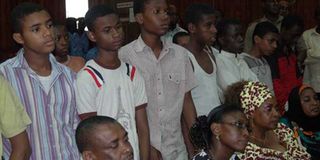Muslim and Somali scholars must challenge Shabaab’s violent creed

Some of the radical youths arrested at Masjid Musa. A radical shift in government policy and one that may bear some fruit is if the scholars can prove that Al Shabaab’s ideology is contrary to the Qur’an, then the terrorist organisation’s appeal among youth could be significantly weakened. PHOTO/FILE
What you need to know:
- The truth is that Al Shabaab has been waging its war primarily against fellow Muslims. Its adherents have killed more Muslims within Somalia than non-Muslims outside the country.
- Somalis have always been devout Muslims, but never extremists. Extremism was imported into the country in the course of the civil war and remains externally driven. The more radical Islamic sects in Somalia are not indigenous; they are foreign imports.
The blanket condemnation of Somalis over the terrorist attacks that have been taking place on Kenyan soil in recent months reflects a general lack of understanding of both Somalia and the terrorist organisation Al Shabaab.
Both the government and the media have resorted to making xenophobic statements that are likely to incite terrorists into more violent action.
The truth is that Al Shabaab has been waging its war primarily against fellow Muslims. Its adherents have killed more Muslims within Somalia than non-Muslims outside the country.
Al Shabaab may have been conceived in Somalia, but its parentage lies outside. Before the civil war, Somalis were Sunni Muslims belonging to the Sufi sect. Today, Somalia is full of alien sects, such as the Wahabi, who were imported from Saudi Arabia and other Arab countries.
IDEOLOGICAL WAR
According to Ismail Ali Ismail, a former Somali diplomat, Somalis have always been devout Muslims, but never extremists. Extremism was imported into the country in the course of the civil war and remains externally driven. The more radical Islamic sects in Somalia are not indigenous; they are foreign imports.
Al Shabaab has disassociated itself from homegrown Somali organisations such as the Islamic Courts Union, which was forced out of Mogadishu by US-backed Ethiopian forces in 2007, and which splintered into various sects that are still prevalent in Somalia.
Al Shabaab’s main tools are propaganda and violence. They must be countered, not through violence, but through a counter-propaganda offensive. This is what the Somali government has finally realised, after having failed to rehabilitate or eradicate Al Shabaab.
Two weeks ago, the Government of Somalia declared an “ideological war” against Al Shabaab by creating a government office for Muslim scholars to challenge the terrorist organisation’s violent ideology and to influence public opinion.
Prime Minister Abdiweli Sheikh Ahmed told the religious scholars that it was their national and religious duty to fight Al Shabaab. He added that the scholars must defend Somalia’s religion, people and country.
It is a radical shift in government policy and one that may bear some fruit. If the scholars can prove that Al Shabaab’s ideology is contrary to the Qur’an, then the terrorist organisation’s appeal among youth could be significantly weakened.
More importantly, if the government and the scholars can show that Al Shabaab is, in essence, a foreign force, the Somali nationalist spirit may be awakened.
In his excellent book, Governance: The Scourge and Hope of Somalia, Ismail says that whenever there has been a clash between religion and culture, the latter has always prevailed. Somalis need to discard the hate-filled ideology of foreigners who prey on poor unemployed youth.
Once the mask has been removed from Al Shabaab and similar sects, they will lose their battle for gullible youth’s minds.
However, the war cannot be fought just on the propaganda front. Illiteracy, poverty, under-development and unemployment are fodder to those who seek to gain political power through religious extremism.
FILLING A GAP
In Kenya’s coastal region and in Somalia, the fight against radicalisation must be complemented with intense and focused development interventions.
The problem of insecurity linked to Islamic religious organisations and mosques in the Coast region, particularly Mombasa, needs a holistic solution that addresses issues of unemployment and poverty.
The government’s response to rising insecurity and radicalisation has been to arrest the youths or to invade mosques with brute force. The result is that the youth are getting further radicalised and extremist Muslim clerics now have more ammunition with which to fight the government and other “infidel” forces.
The government and security forces must address the bigger question of why youth in places like Mombasa, Kwale and Likoni are tempted to join radical groups that spread violence.
They will see that there is a clear link between under-development, high youth unemployment particularly among males, and radicalisation.
Al Shabaab has taken advantage of this link. It must be broken.





